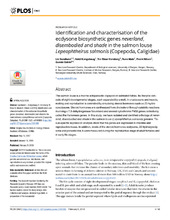Identification and characterisation of the ecdysone biosynthetic genes neverland, disembodied and shade in the salmon louse Lepeophtheirus salmonis (Copepoda, Caligidae)
Peer reviewed, Journal article
Published version

Åpne
Permanent lenke
https://hdl.handle.net/1956/19165Utgivelsesdato
2018-02-05Metadata
Vis full innførselSamlinger
Originalversjon
https://doi.org/10.1371/journal.pone.0191995Sammendrag
The salmon louse is a marine ectoparasitic copepod on salmonid fishes. Its lifecycle consists of eight developmental stages, each separated by a molt. In crustaceans and insects, molting and reproduction is controlled by circulating steroid hormones such as 20-hydroxyecdysone. Steroid hormones are synthesized from cholesterol through catalytic reactions involving a 7,8-dehydrogenase Neverland and several cytochrome P450 genes collectively called the Halloween genes. In this study, we have isolated and identified orthologs of neverland, disembodied and shade in the salmon louse (Lepeophtheirus salmonis) genome. Tissue-specific expression analysis show that the genes are expressed in intestine and reproductive tissue. In addition, levels of the steroid hormones ecdysone, 20-hydroxyecdysone and ponasterone A were measured during the reproductive stage of adult females and in early life stages.
